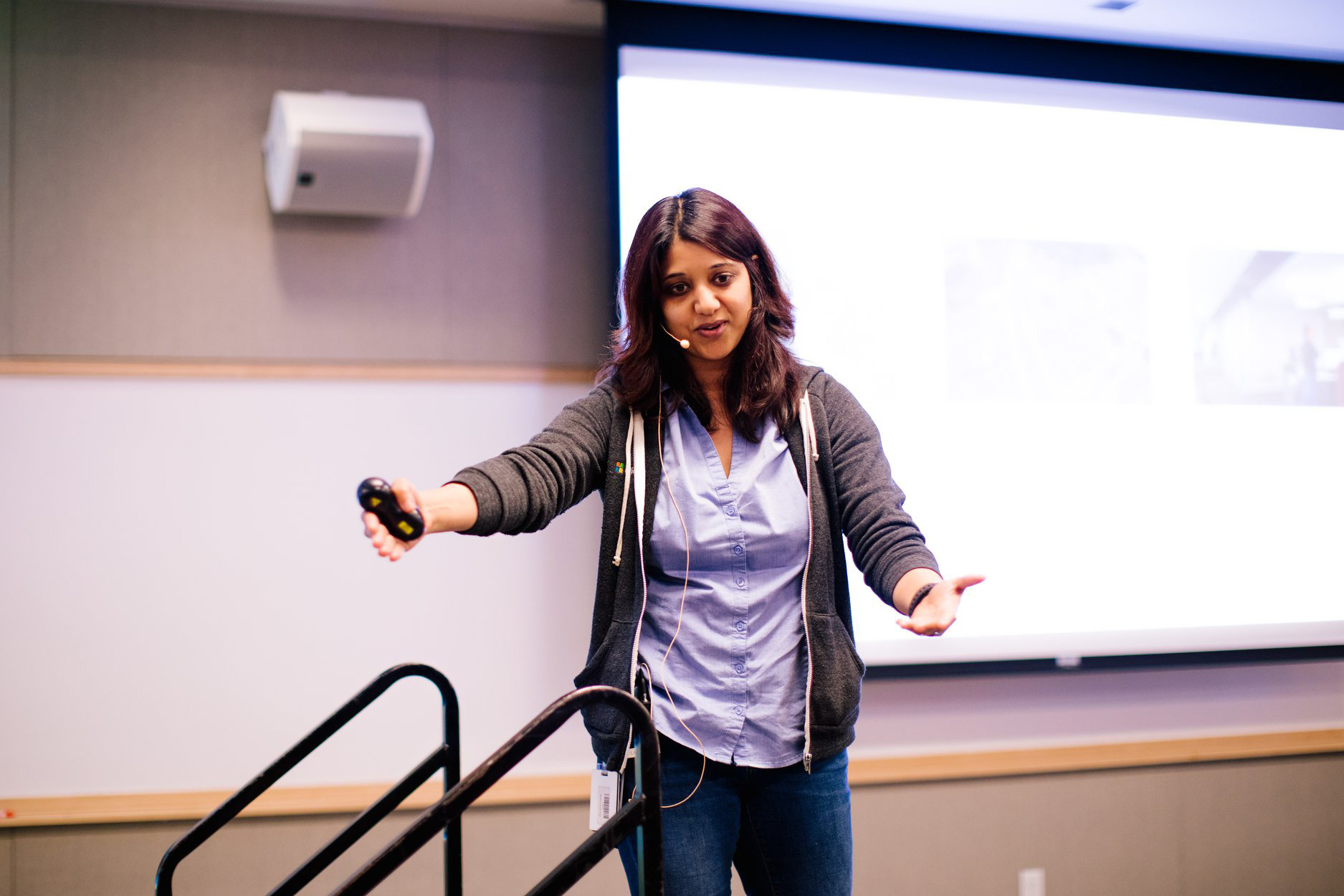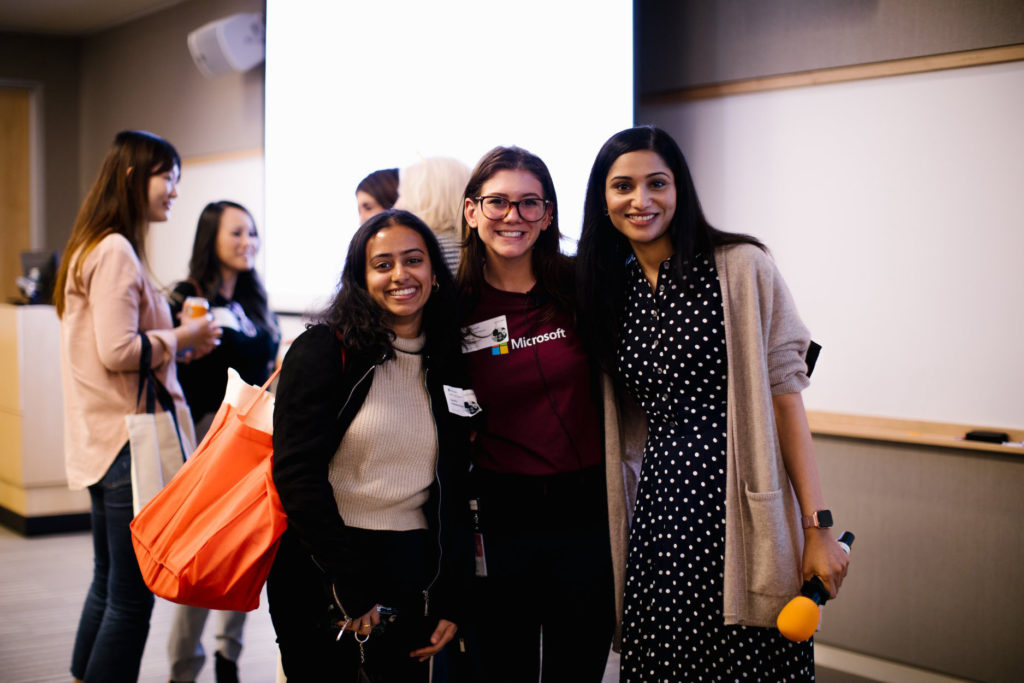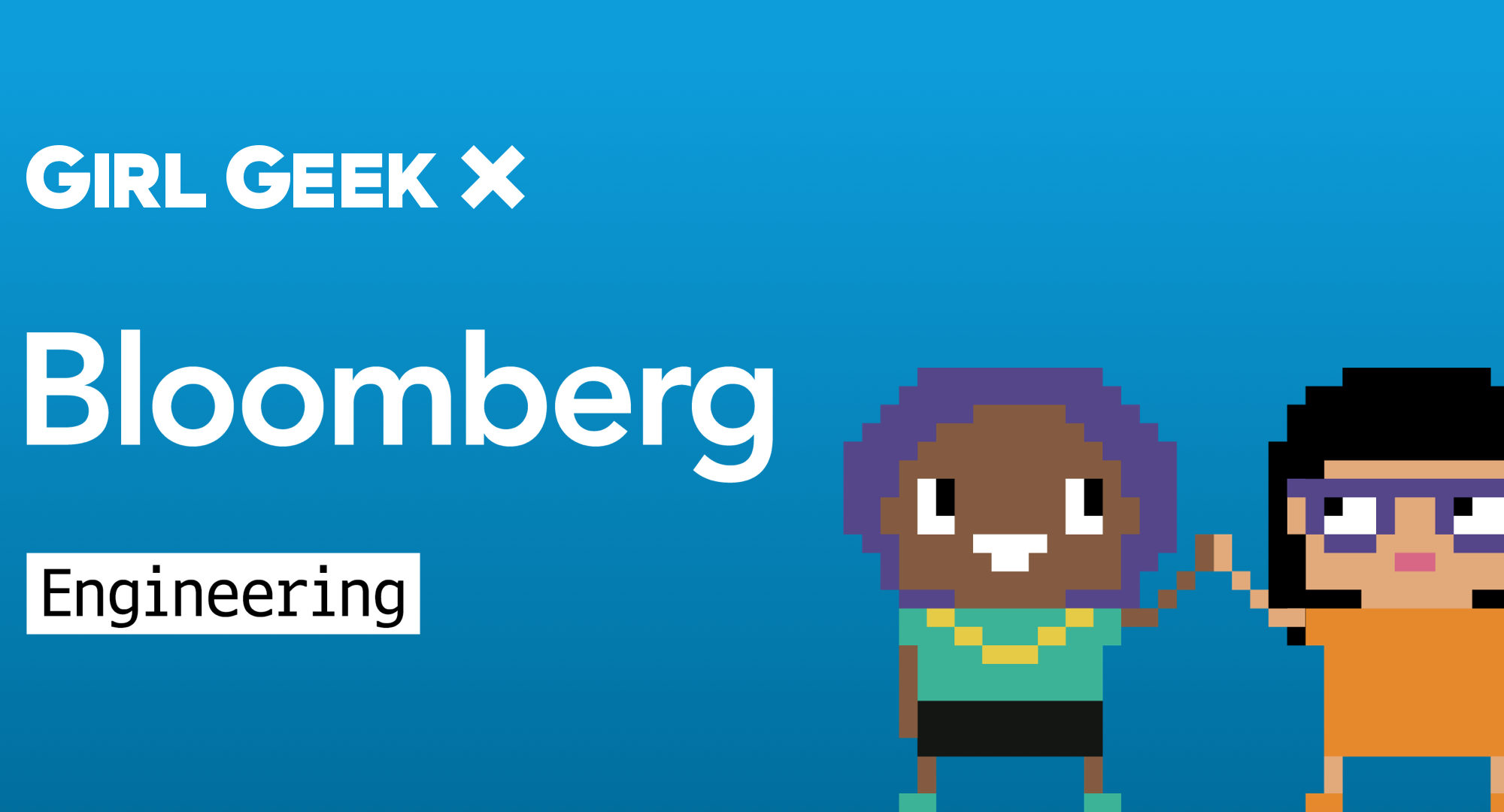Like what you see here? Our mission-aligned Girl Geek X partners are hiring!
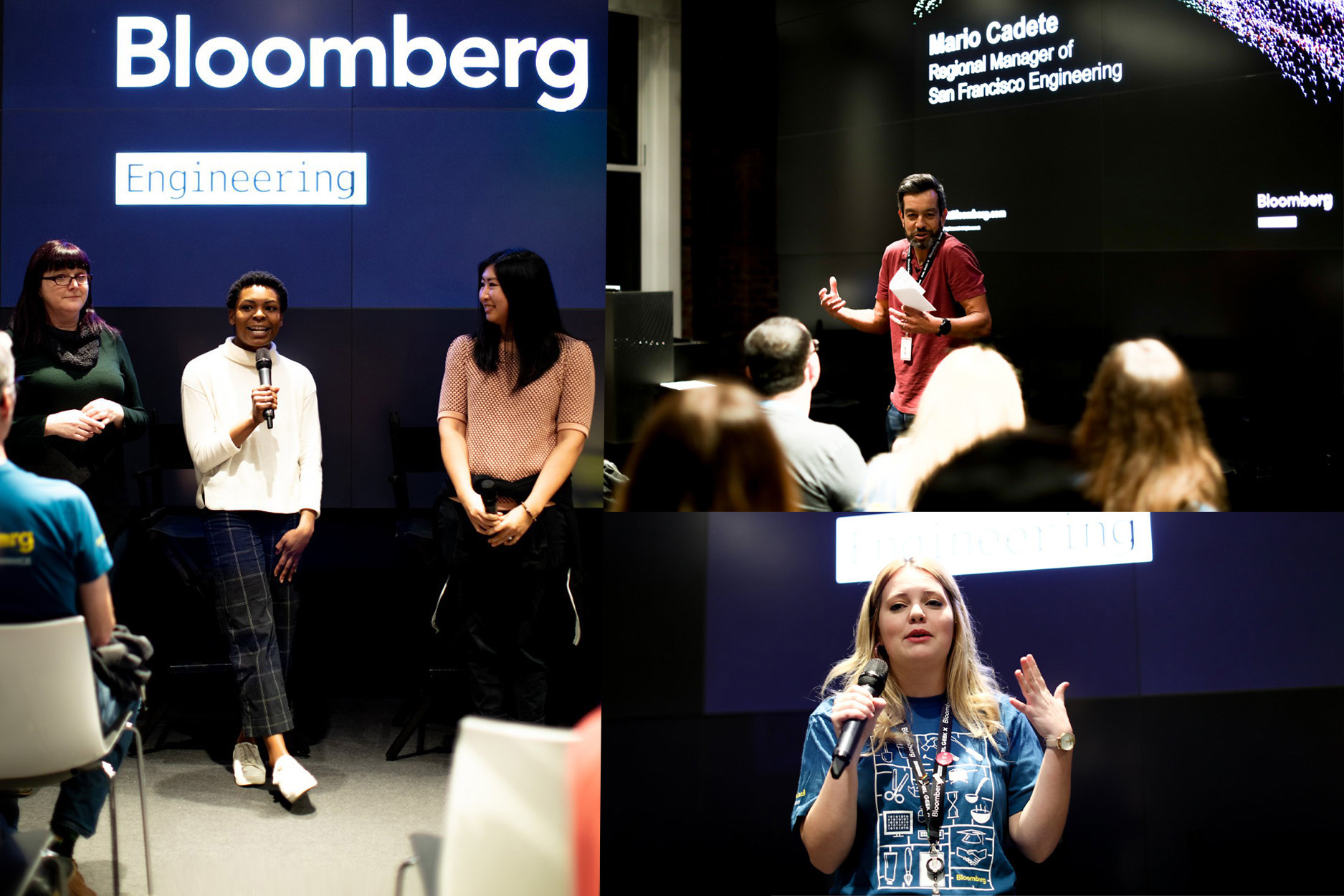
Girl Geek X Team (Gretchen DeKnikker, Rachel Jones, and Angie Chang) and Bloomberg Engineering (Mario Cadette and Bailey Frady) welcoming the crowd at Bloomberg Engineering Girl Geek Dinner in San Francisco, California. Erica Kawamoto Hsu / Girl Geek X
Transcript of Bloomberg Girl Geek Dinner – Lightning Talks & Panel:
Bailey Frady: All right. Hello everyone. How are you all doing? Good.
Audience member: Good.
Bailey Frady: Good. How was the food?
Audience member: Delicious.
Bailey Frady: Great, glad to hear it. Well, my name is Bailey and I just want to officially welcome you to Bloomberg Engineering. We are so glad to have you here. I know there’s a lot of places where you could spend your Thursday evening, so we’re really thankful you chose to invest your time here. Like I said, my name is Bailey. I’m a project manager here and I have been working with the phenomenal Girl Geek team to put this event on for you. So without further ado, please help me welcome Angie, Gretchen, and Rachel.
Angie Chang: Thank you. Hi, my name is Angie Chang, founder of Girl Geek X. I wanted to say thank you for coming out to check out Bloomberg Engineering tonight in San Francisco. If you haven’t seen the sting rays, you’re adorable. And I’m so glad that we’re here to hear from some really amazing Girl Geeks tonight.
Rachel Jones: Hi, I’m Rachel. I’m the producer of our podcast and if you haven’t listened to it before, I would encourage you to check it out. We have a lot of really great episodes. My favorites, we have one on branding, one on self-advocacy. They’re really great. Season two is starting really soon. We’re going to be trying some new stuff. Our first episode of season two, we’re actually answering your questions that you sent in through our survey. So yeah, give it a listen.
Gretchen DeKnikker: I’m Gretchen, thank you guys. Who’s, this is their first Girl Geek event? so we have a lot of returning. Welcome back. Thank you for keep coming. Most of you know that we do these almost every week. The little known secret is you can do one at your company also. So if you want to find out what it’s like, find Bailey who’s been working so hard on this has been our interface and yes.
Gretchen DeKnikker: And Noor is around somewhere also. And then I’m sure there are a ton of other people that have been working on this, but ask them what it’s like and what it’s taken to put it together and think about doing one of your own. And then if you guys have seen our emails lately, I’m trying to stop saying you guys and I did it.
Gretchen DeKnikker: If y’all have seen our–Be a proper feminist when you’re on camera! Okay. So if you’ve seen emails lately, we just launched registration two days ago for our annual virtual conference, which is called Elevate. And we have amazing lineup. We have Carin Taylor, who’s the chief diversity officer of Workday. We have the CTO of Intuit, Marianna Tessel, just an amazing, amazing lineup.
Gretchen DeKnikker: It’ll all be targeted for like mid-career women. So not just as much early stage content, but like for everybody else too. So register, it’s free. If you’d like to get involved, tell your company. It’s a really great sponsorship opportunity too. And without further ado, let’s kick this off tonight. Okay, cool.
Narrator: Go. Two letters. One syllable, a revolution, a world of potential in a single keystroke. The central nervous system of global finance was imagined and engineered more than 30 years ago. In 1981, Mike Bloomberg and his partners saw an opportunity to bring digital innovation to an industry where information was transmitted slowly and inefficiently.
Narrator: They built the Bloomberg Terminal, one computer system that allowed investors the same real time access to financial information at the same time, no matter their location. It was a product of the future willed into existence, a continuously evolving system built upon pioneering technology that transformed global capital markets forever.
Narrator: We empower people to make critical, transparent, and informed investment decisions while reducing risk and creating the tools of tomorrow. At Bloomberg, we are constantly thinking about and investing in the future. Always going where others aren’t, can’t, or won’t. We’re rolling out hundreds of new products and enhancements every day with our ears to the ground and an eye towards the future. We connect people in ways and at speeds no one else can. We process 100 billion market data messages daily, peaking at more than 10 million per second.
Narrator: Our 15 million distinct streams of financial data transmit in 13 milliseconds, 27 times faster than the blink of an eye.
Narrator: Our reporters break news from locations other news organizations have yet to visit. We have the largest business new staff producing more stories from more places than anyone else in the world, 120 countries and counting. We work around the clock in every time zone, never shutting off, never powering down because that’s what our customers require, access from wherever they are, whenever they want, however they choose to connect.
Narrator: We have over 5,000 technologists and computer engineers, a full 25% of our workforce, designing new functions and products before customers even know they need them. Innovation and collaboration are the reasons for our continued success. It’s how we’ve always worked and it’s what will guide us forward, with over 175 locations we are investing in our employees by building the workplace of the future.
Narrator: We go further. Stretch our impact farther. We use our power to connect people to create positive change for the entire planet, not just our bottom line. Through Bloomberg Philanthropies, we invest almost all of our company profits to address the most urgent public challenges generating the greatest good for the most people. It’s our purpose.
Narrator: We are vigilant in organizing and interpreting information in a complex, ever changing world. Looking decades into the future and engineering what our clients will someday need has been our mission from day one. We’ll never stop building, growing, and staying true to our original innovation. Go deeper. Go where others aren’t.
Mario Cadete: Hello. Hello. Hope you enjoyed the video of our company. Thank you, Girl Geek, for making tonight possible. Thank you all for coming. Thanks, Bailey, for putting this together. My name is Mario Cadete. I head up our Bloomberg San Francisco engineering office. A little fun fact about our office. It was custom designed for software engineers. So we really like that and we were all engineers and we like to have it as our little-
Audience Member: Sting Rays.
Mario Cadete: Engineers like Sting Rays, I’m told. We have this floor, the floor above us. It’s a little smaller, cozier than our other offices. But we like it that way. We’re due to get another floor later this year and we’re really excited. That’s going to allow us to add another 50 engineers to our workforce here in San Francisco. Personally, just a little bit about myself. I’m fairly new to the Bay Area, so I’m looking forward to meeting many of you after the program.
Mario Cadete: I started my career in Bloomberg engineering in 2000, and I’ve seen some of the 20 years. I get that facial expression a lot, especially when you interview candidates that come in. Yeah, it’s a long time. During that time, I had great opportunities to work on many challenging projects in New York, in London, and now in San Francisco.
Mario Cadete: What kept me at the company over these years are really three main areas. And they’re should… they’ll come out tonight in our agenda. First I love tech, and you’ll hear more about that in our first panel on how to thrive in open source. So that’s going to be really exciting. Secondly, I care deeply about our commitment to D&I. I know I’m in a role that I can be a key ally to women in technology and I don’t take that lightly.
Mario Cadete: I think about it often and I hope it shows in my leading of this office. And you’ll hear more ideas to make your workplace more inclusive in our fireside chat, taking an employee resource community from idea to impact. And lastly, I love as a company how we give back. It’s in our DNA.
Mario Cadete: As a company we donated almost a billion dollars to charity in 2018, $1 billion. So a lot of money. Also in that year myself and almost 20,000 of my colleagues donated over 150,000 hours to charity and communities where we live and where we work. But most importantly to me is how we invested in our employees. I take great pride in seeing our people develop both professionally and personally.
Mario Cadete: So as an office, in addition to the project work that we do, we hosted over 100 events that range from professional development to clubs like Bloomberg Women in Technology to tech community events like this.
Mario Cadete: Our culture is one of the main reasons that my colleague Dobs decided to join us a couple of years ago. You’ll hear more about that during her lightning talk and how to find a dream job in tech. So enough about Bloomberg for now, if you have any questions, please ask me or somebody in one of these stylish blue t-shirts, ‘cuz there are a couple of them around, after the program.
Mario Cadete: So let’s move on to what you came here for. Valuable insights to advancing your career and meeting other incredible women working in Silicon Valley. Without further ado, I’m proud to introduce my colleague, Danica Fine, who will lead a panel discussion on how to thrive at open source. I hope you enjoy. Thank you.

Bloomberg Engineering Software Engineer Danica Fine moderates Stephanie Stattel and Paul Ivanov in a panel conversation on how to thrive in open source communities at Bloomberg Engineering Girl Geek Dinner. Erica Kawamoto Hsu / Girl Geek X
Danica Fine: Can you hear me? Yeah. Okay. I said it earlier today, I was really excited about the director chair. This is great. Thank you so much for giving me a director chair. Well, hey everyone. Welcome to our panel on how to thrive in open source software communities. We have a great program for you tonight, but before we get started, I really want to see a show of hands, how many of you are familiar with or already involved in using open source technologies?
Danica Fine: All right. Good. That’s good. You’re on the panel.
Paul Ivanov: Please.
Danica Fine: Who are you? How many of you are participating in these open source communities already? Or maybe even actively contributing code back to these open source projects? All right, quite a few. So I think we have a good mix in the audience tonight. I know that some of you didn’t even raise your hands, so I hope like by the end of this you’ll know what we’re talking about. So hopefully, our panelists can shed some light on the subject.
Danica Fine: So as Mario, mentioned we have with us tonight three of our star engineers. We have Stephanie Stattel, Paul Ivanov, and Kaia Young. Before we dive into questions, why don’t we introduce ourselves. Paul, let’s start.
Paul Ivanov: Hello. I’m Paul. I’ve been at Bloomberg for three and a half years. I work largely in open source on the Jupyter Project. So I’m one of the steering council members and was fortunate enough for the project. If you don’t know Jupyter Notebooks are a way to do data analysis in different languages and to communicate your results with colleagues so that you can rerun it and so that they can rerun it. And so I’ve been working on that since before the project existed as Jupyter, as IPython, and we were fortunate enough to win the ACM Software System Award in 2017. So it’s great to be able to contribute to this tool and give back to the community and continue to do that here.
Danica Fine: Stephanie?
Stephanie Stattel: Hi. Yeah, my name’s Stephanie Stattel. I’ve been at Bloomberg going on nine years now. I moved out to San Francisco two years ago to work on the team build- working with Jupyter, building a data science platform on top of Jupyter. And right now for the past year, I’ve been working on an infrastructure team, so I’m sure many of you saw the terminal demo. The team that I’m on works really closely with Chrome and the windowing stack that supports the terminal. So happy to chat with anybody about that after the panelists and talks.
Kaia Young: And my name’s Kaia Young, I’ve been with Bloomberg also about two years, here in the San Francisco office. and I’m an engineering manager here for a new team that’s focused on data visualization and tooling for a new data science platform that we offer. So my team develops data visualizations and some of the platform related to that, largely built on a lot of open source technologies like D3, Vega, pandas, NumPy, a lot of the kind of general Python data science stack that you all may be aware of.
Kaia Young: So we do develop tools for internal use as well as contribute to those libraries that we do use.
Danica Fine: Thanks. All right, let’s get started. Stephanie. So you mentioned your involvement with project Jupyter. Can you tell us more about how you got started in the Jupyter community and like what was that journey like for you?
Stephanie Stattel: Yeah, sure. So I can say that when I started on the Jupyter team, that was my first exposure to the open source world and communities. So needless to say it was a little bit intimidating. When you go to a github page and you see a list of issues and a lot of activity in terms of pull requests, it’s really hard to know where to get started. And so something that I really appreciated about the Jupyter community in particular, there’s so many in person events, conferences, workshops, hackathons, and studio days. And so for me, that was my real entry point, getting to know the people behind the community.
Stephanie Stattel: And it was a really great way to find the projects that I was interested in working on and what lined up with what the community was developing. So in something like a full studio day event, you find people of all levels of expertise. People like Paul who have been with the project for over 10 years. People who like me had never used Jupyter, made an open source pull request before and we’re all working together. So I think for me it was a great mentoring opportunity.
Stephanie Stattel: And I think when you’re looking for open source communities to engage with, it’s really important to find ones that have a really welcoming environment where it’s okay to ask questions and be new at things. And I think it really speaks to the growth we’ve seen in a project like Jupyter where it really takes into people with a lot of different viewpoints and is open to kind of pursuing different avenues. And I think that’s why I’ve stayed active in the community for as long as I have. Yeah.
Danica Fine: I really appreciate hearing your perspective on that. ‘Cause like, I’m sure a lot of us didn’t realize how simple it could be to get involved. And, as someone who’s kind of outside of the community like you’ve actually made it sound a little less daunting, a little more welcoming. So thanks.
Danica Fine: So Kaia, your Bloomberg product is built on top of open source technology. Could you give everyone an idea how you’re able to leverage this technology and your team? And as part of that, how are you interacting with that community?

Bloomberg Engineering Team Lead Kaia Young (right) talks about open source communities at Bloomberg Engineering Girl Geek Dinner. Erica Kawamoto Hsu / Girl Geek X
Kaia Young: Yeah. I mean working with the open source community in the context of business product is a little bit different than doing it as an individual contributor or just as anything else. So there are kind of some interesting challenges there as well. But even besides that, I think there’s a lot of advantages to working with open source software even in the context of business. Like for example, you can get to market a lot quicker. Why spend a lot of time making something that other people probably already made better definitely than me.
Kaia Young: So also with that it kind of gives company this ability to focus more on our core competencies. Like for example, Bloomberg, we’re very, very interested in the financial side of things. So leveraging a lot of good open source technology gives us a way of kind of getting those products out there a little bit faster so that we can focus on the particular value that we add.
Kaia Young: I think interacting with the community is a very, very kind of interesting thing. Mainly because I think one of the areas that we’ve been able to be successful in is having good relationships with those communities. So some of the strategies we do there is we try to really build an understanding of who’s using the open source software. I think sometimes it can be really, really easy to kind of be focused on the particular thing that you want to do.
Kaia Young: Whereas some of the technology we’re using are used for all kinds of, of things. Like Jupyter itself is used for academics, for research, all over the place. So really spending the time with the community and the stakeholders in that community to really kind of gain an understanding of who’s at the table? What are people using it for? So that then we can position ourselves to understand what the roadmap is, and then how we can actually be a part of that.
Kaia Young: One of the things we do want to avoid is obviously saying that, this is something that we want to contribute to. How can it help us? I mean, that’s not what we want to do at all. So from our perspective it’s really important to kind of understand where the community is so we can see where we can act.
Kaia Young: Essentially it’s kind of a forced multiplier. So by understanding that we can identify expertise that we have that may be valuable to the community and then work together to make a product that everyone can be used and used for. I think it’s really interesting to hear kind of Paul’s perspective on it. Jupyter in particular, having gone for so long and being used by so many people. I’m not saying you’re old-
Paul Ivanov: Thanks.
Kaia Young: … but it’s like, [inaudible]. But some of the Jupyter events that I’ve been at, it’s like really, really amazing to see how some of the software that’s being used. So like for seeing some of the stuff that I’ve developed being used, I think at the last event there was being used to predict weather, there was a government demo on fluid dynamics. They’re using it to find new planets. And then like, I just made a thing that puts some stuff on the screen, but it’s like really, really cool to be able to see that we can also contribute back.
Kaia Young: So rather than just being focused on the needs of our consumers and our clients that we can actually kind of give something back to the community that’s used for research and all these other things.
Danica Fine: That’s awesome. I think it’s like really interesting to see how does that go back and forth rather than your team just taking this product and utilizing, but like it seems that there’s like a lot of effort on both sides to make this build and maintain this sort of partnership. So, Paul, as someone who is a leader in the Jupyter community, as so many people have alluded to. You’re great. Could you speak to how you maintain the community space that both fosters inclusiveness and mentorship, and then also supports these external partnerships such as the one that Kaia had mentioned?
Paul Ivanov: Right. Yeah. I think it’s useful to sort of take a step back and make the point that like, even though we’re talking about open source, like it’s one thing, it’s no monolith. So there’s different scales. And so maybe I’ll just go through some of the history of like how Jupyter came to be here and how I’ve participated in it. And that’ll help sort of shed light with how I think about this.
Paul Ivanov: And so I think the, the best way to get involved with open source to scratch your own itch. So if you have something that is bothering you, whether or not it’s making your own project around that, or finding a project that’s already helping you somewhat and then changing it for your needs, I think is a very good way. And that is the way that I started with IPython, which then led to IPython Notebooks.
Paul Ivanov: So when I was in graduate school, we were using these tools for ourselves to do our data analysis. Okay? And we knew that we wanted to share that with other scientists and with the world at large, but we didn’t have resources for that all we… it was entirely volunteer run.
Paul Ivanov: And so then in 2013, I think we got the first grant from the Sloan foundation, where for the first time, we had seven paid positions to work on this tool, IPython notebook, which already existed but was rough around the edges, full time. So we were able to continue that work, but now we sort of started to shift away from being users of the tool. We were still using it, but now we… like our jobs were to make the tool and not necessarily just use a tool.
Paul Ivanov: So it’s sort of another iteration of that. And so we were still very close to our users and we were still users ourselves. But as more people and companies started to come on board, so it’s not just funded in academia anymore. We have companies that are joining the efforts and resources and more engineers that are joining the efforts. We needed to come up with a governance model and that’s always a struggle.
Paul Ivanov: At our level, that’s one of the big issues is like which way do… which direction do we go? How do we go? And how do we keep the stream of people coming in? And so one of the ways in which… and so to me it was like going from, “Oh, this is the thing I do for fun and nobody pays me to do it because this is awesome,” to, “Somebody is paying me to work on this fun thing that I am doing,” to like, “Oh man, lots of people are actually using this thing.”
Paul Ivanov: I need to make sure that we keep people coming in and thinking that this is fun, and so that it’s not just the job. Because we now we have contributors and leaders that for their entire involvement in the system, they were paid to do that work. That’s just like weird for me. Because for me it was like… it was all of our friends that were just, “Yeah, anybody can contribute. Like we’re clearly going to use this.”
Paul Ivanov: And then there’s some people that have always been paid now to work on Jupyter and that’s great. It’s like it’s weird. It’s like a family that grows and then that also is its own employer. Like it’s a family business. I don’t know.
Paul Ivanov: All right. But what’s happened is as we grew, and this happens to large open source projects, is that there kind of isn’t necessarily room for people to be able to plug in and explore new ideas.
Paul Ivanov: Like, we’re, lots of open source projects have this notion of sprints where there’s work to be done and you can show up and we can hand you out tickets and it’s a bite-size ticket that you will be able to do either on your own or with a little bit of handholding. And I thought that, well, when we were just using these tools on our own, we used to just be very close to it and we used to explore stuff. We did stuff that nobody… we didn’t have to justify. We didn’t have to have a business justification for doing things.
Paul Ivanov: And so that’s why for about a year and a half now, I’ve been helping with my colleagues at Bloomberg running these Jupyter open studio days. So it’s a two day event where anybody of all levels, experience with tech or not, can come to our office here. And it’s kind of like a house party. It’s kind of like a hackathon, but it’s unstructured. It’s deliberately unstructured so that we can plug you in wherever it is that you want to plug in and we can have a conversation about things and to sort of have more of this incubation period. And so that’s sort of… I’m very fortunate to be involved in this.
Danica Fine: This has borderline become the Paul… Paul Ivanov show. Anyway…
Paul Ivanov: Sorry. I did not want to do this-
Danica Fine: I’m really glad that there are leaders in the community though, that are like you, who are making these opportunities more accessible to people. So I really do appreciate that. That’s the end of our deep, heavy questions, lightning rounds. I’m so excited. One to two sentence answers, please.
Danica Fine: You go over and I will come after you later. Stephanie, what advice would you give to someone looking to get involved with the community?
Stephanie Stattel: I’m going to do longer sentences and [crosstalk] junctions.
Paul Ivanov: [inaudible] on this.
Stephanie Stattel: I think for me, something I would say is don’t be afraid to dip your toe into the pond of open source and really look for a community. And I think I’ve definitely found that in places like Jupyter and Electron that really thrive on bringing new people and fresh ideas into their ecosystem.
Stephanie Stattel: I think that’s really important when you’re deciding where to spend your energy. You really want to work with people that are open to new thoughts and kind of like you’re saying, exploring where a platform can go. I think it sort of, for me sort of red danger zone if there’s sort of a timeline that’s mapped out because in reality I think projects evolve in really creative and surprising ways, and so I think you want to find sort of a tribe of open source communities that are open to where a project is going to go. Because I think I even Kaia mentioned this, you really have no idea what you’re building, who’s going to end up using it.
Stephanie Stattel: And I think being open to the possibilities really broadens the horizons for where what your work can do can have an impact. And so that would be my advice kind of…
Danica Fine: You have one more sentence.
Stephanie Stattel: Two sentences. I do?
Danica Fine: Oh that was [inaudible]. Okay, we’ll end it there. Kaia, what do you wish you had known when you started working with open source software?
Kaia Young: What do I wish I would’ve known? It’s kind of interesting to go back to something Paul said earlier, what’s really interesting about open source software is that there are so many different flavors of it. Like some is just companies open sourcing their own software. You have like academics making things and then sometimes just one person wanted something and then put it out there.
Kaia Young: Previous to my career as an engineer, I was a musician and one of my least favorite things in the world was like the unsolicited email of someone saying like, “Hi Kaia, here’s everything that’s wrong with your entire body of work.” And so I find this really… it’s one thing that is really important to bring to open source is kind of a mindset of respect, humility. These things go a long way because it’s really, really easy to look at an open source project, get on there and say like, “Hey, why don’t you have this feature? This should be designed this way instead,” when you don’t know the story about how that project got there.
Kaia Young: It could have been just one person working on it constantly and sacrifice quite a bit for it. So little respect and humility goes a long way. It’s a lesson for me.
Danica Fine: I have learned tonight that our engineers can’t count to two. Okay.
Paul Ivanov: It’s two in some base.
Danica Fine: Paul?
Paul Ivanov: [inaudible]
Danica Fine: Okay. Last question for you Paul, and it’s a doozy. Are you ready? When is the next Jupyter open studio? Is it true that anyone can get involved?
Paul Ivanov: Yes and yes.
Audience Member: Yay.
Danica Fine: Great. We’re done. It’s fine. It’s fine.
Paul Ivanov: It’ll be probably early Spring and so we’ll probably not make the February… late February cutoff, but it’ll probably be early March, somewhere around there.
Danica Fine: We’re good.
Stephanie Stattel: Will people go to see the announcement? Sorry.
Paul Ivanov: Uh-huh (affirmative).
Danica Fine: You can ask questions. This is my official job. It’s fine.
Stephanie Stattel: Sorry.
Paul Ivanov: Tech at Bloomberg will definitely retweets me whenever I tweet about it.
Danica Fine: Oh, do they?
Paul Ivanov: So yeah.
Danica Fine: I didn’t know that. Cool.
Paul Ivanov: Because I know a few people that work at Bloomberg, so it’s really great.
Danica Fine: You’re working? Okay. Great. Yeah. Awesome. Those are all the questions that we had planned for tonight. I’m sure you have more questions for our panelists. So afterwards at the networking session, please reach out to them, pick their brains, clearly they have nothing else to do, so that’d be great. Have fun with the rest of the program. It’ll be wonderful.
Paul Ivanov: Thank you.
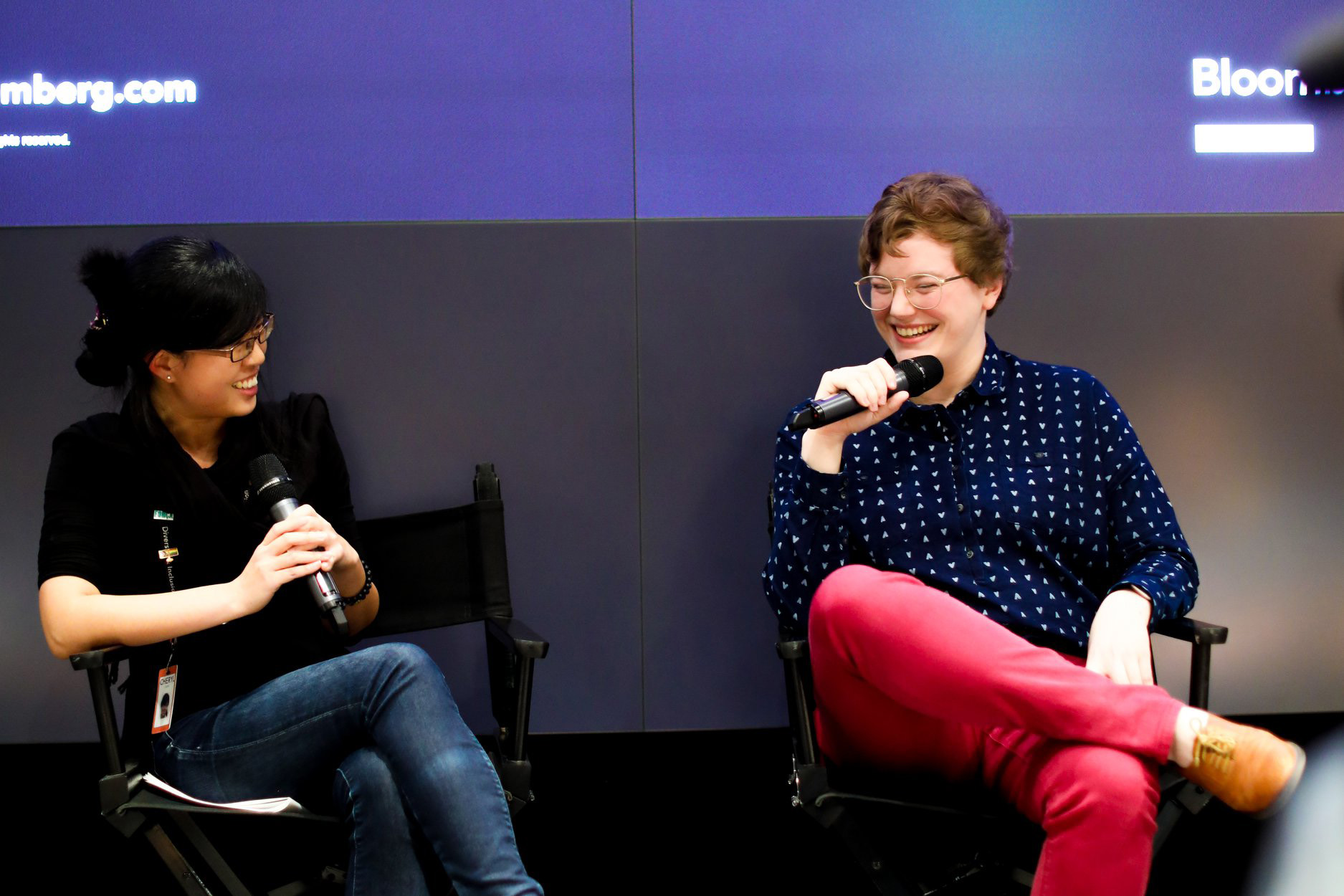
Bloomberg Engineering Team Lead Cheryl Quah speaks with Software Engineer Rebecca Ely about taking an employee resource group (or community) from idea to impact at Bloomberg Engineering Girl Geek Dinner. Erica Kawamoto Hsu / Girl Geek X
Cheryl Quah: Hello. Good evening.
Rebecca Ely: Hi, everyone.
Cheryl Quah: Hello.
Paul Ivanov: Hello.
Cheryl Quah: Good. Danica. This is my first time sitting on this chair. Feels pretty great. You’re lucky. No, I actually I kind of prefer standing up, but we’ll see. Anyway, welcome everyone to Bloomberg to our little corner of San Francisco with our little stingrays. My name is Cheryl. I’m an engineering team lead at Bloomberg. I’ve been here I think coming to eight years now, so not quite as stretch as Mario, but still getting there. I started out in New York and moved over to San Francisco about three and a half years ago.
Cheryl Quah: And I’m very privileged to introduce Ely. Ely started out as a peace and justice studies major. Thank you. And had a career in government contracting before joining the Hackbright Developer Bootcamp and then leaping… Yeah. Wait, where are the woos coming from? Anyone in the audience? There we go. And then we’ve been so lucky to have Ely with us for the past three to four years at Bloomberg. More specifically to the topic at hand tonight. Ely has been active in essentially all of the communities, or what we call Employee Resource Groups, that we have at Bloomberg in the San Francisco office.
Cheryl Quah: I don’t know where you find the time for that. I’m not going to ask. But and in particular she’s been part of the steering committee for the Bloomberg Women in Technology Allyship Group. And so also a little bit about me is that I’ve been very fortunate when I was in New York to be part of the exciting journey of helping to start the Bloomberg Women in Technology Community that is now being taken over and led by many wonderful other people here like Ely, like Stephanie, and all the other wonderful folk here.
Rebecca Ely: Sorry. Cheryl is downplaying it. She’s basically a celebrity at Bloomberg.
Cheryl Quah: That’s not true. But so why are we here today? We’re here today because clearly, creating and sustaining an employee resource group or community is something that’s very close to both of our hearts. And I guess just to take a step back, how many of you here are involved in an employee resource group at your organization? A good number. Not as many as I thought, but that’s interesting. How many of you who are involved or have found that your community, your employee resource group has been impactful to you personally, either you’re in your career or just in your overall happiness? All right.
Cheryl Quah: All right. How many of you are interested in getting more involved with starting an ERG at your company or figuring out how to increase the impact of the ERG at your company?
Cheryl Quah: Good. All right. So that gives us a few people to talk to tonight. So I think the reason why I’m here and, why we wanted to chat tonight as well was because if you have been actively involved in a community or an ERG then you probably are aware of how much work it takes. Yeah, I see a few nods there. It got you. You’re aware of how much work it takes, how much effort goes into running the community just to organizing a single event, shout out to Bailey, again, shout out to all the organizers of this event, shout out to the Girl Geek organizers.
Cheryl Quah: It’s just… it’s a massive amount of effort. And I think for me personally over the years as I’ve gained experience, sort of what I’ve come to realize and what one of the driving questions for me nowadays is, I always ask nowadays, “How can I be sure, sure that the effort and the work that I’m putting in is paying off? What are the specific outcomes that I actually want to achieve? And is the effort that I’m putting in going… actually moving the needle in some way on those specific outcomes that I’m interested in achieving?”
Cheryl Quah: And so for tonight, we wanted to share some stories from our personal experiences regarding that. And I think in your abstract it says something about launching, growing, and sustaining an ERG. Nobody else remembers what the abstract says, but in this spirit of saying what we advertised, we’re going to start with those questions. So in terms of launching an initiative. Bear with me and the Hamlet moment that Ely and I came up with a short while ago.
Cheryl Quah: So when we are launching an initiative, the three questions that I sort of encourage everybody to ask themselves and that we ask ourselves nowadays is, why are we doing this? Why are we doing this? Why are we doing this?
Rebecca Ely: Yeah, so the answers to those questions from an allyship perspective, at least for me, there’s an entire steering committee, in terms of why are we doing this? I think that there are endless reasons to care about diversity and for allyship more specifically, a lot of the work that happens in companies to improve the environment that folks come into and to improve statistics and to improve outcomes, that falls on the communities that are experiencing the gaps themselves much of the time.
Rebecca Ely: And so allyship very… people have a lot of opinions about the word ally, but it is… we were kind of seizing this swell of support that we have within the women in tech community that is not people who identify as women in tech to really try to shift some of the burden of the work to be done to move towards equity onto people who are already benefiting from the system.
Rebecca Ely: In terms of why are we doing this? I would say so, there’s a lot that companies can do to bring in sensitivity training or stuff like that from outside. You can do surveys and try to take the temperature of the company. But at the end of the day whereas on the ground initiative that was just started by individual contributors who cared. We have access to a lot of information that we’re sort of uniquely positioned for. And so we do a lot of workshops and trainings that are a content we designed based on… What did I call them? Based on like sessions we hold with employees to find out what gaps they’re personally experiencing and what would matter most to them to cover in these trainings.
Rebecca Ely: So we are sort of synthesizing what we’re learning from the people that we really care about supporting and then disseminating that across the company. And we also have a lot of really great access to senior leadership. If I get in a room with a senior leader, I’m not just saying, “Can you do this, this, and this for me?” I’m also saying, “I know what people are thinking. I know what people are talking about. What would you like to know from me? How can we work together to fill gaps? What are you already working on? Where, what are we already working on? What still needs to be done?” That sort of thing.
Cheryl Quah: Thank Ely for talking a little bit about the allyship initiative and I guess… Sorry, go ahead.
Rebecca Ely: Just one more thing on the why are we doing this, which I kind of already addressed, but just there’s also… on the topic of who gets involved in this kind of work most of the time. Mostly it’s not people who are benefiting from the way the systems already are. And so doing trainings on gender equity in the workplace that are attended all by people who already believe is definitely worthwhile in its case. But I think we can have a really solid impact by focusing on people who aren’t necessarily already bought in, who haven’t thought about this stuff much, who are learning for the first time from our workshops, what they could be doing better.
Cheryl Quah: So thank you, Mario.
Rebecca Ely: Thank you.
Cheryl Quah: I got a clap there. I thank you. And so just putting on my… in a former life maybe I would have been a professor, so I get a chance to do that occasionally but nobody else wants to hear that. But anyway, so just to sort of rehash what we were trying to say, it’s that if you’re thinking about getting involved in effort you know is going to take energy and time on your part, think very clearly about your objectives. Think, why are we doing this? Think, why are we doing this? Meaning what is your specific value add here?
Cheryl Quah: And then why are we doing this? Meaning that for the specific outcome that you want to achieve, there are many different paths that you can take to get there. What are the paths that maybe have the highest return on investment? Because all of us have a finite amount of time. All of us have a finite amount of energy. What are the options that you can pick that would really move the needle for what you want to achieve.
Cheryl Quah: I got a five-minute signal over there. You might be going a little bit over. But the second part of the abstract said, growing an initiative. If you think about the word growing, there are two ways to think about it. One is sort of the more intuitive thing, which is just thinking purely about numbers. For instance, my employee resource group had 200 members last year and now has 400 members this year, or my community hosted six events last year and hosted 12 events this year.
Cheryl Quah: So that’s one way to think about it. But the way that I like to think about it, is how are we growing our impact? Ely, can you tell us a little bit more about how you think about that with regard to the allyship initiative?
Rebecca Ely: For sure. So I think that they’re both are important, if you’re having a really phenomenal impact and changing hearts and minds, but you’re changing two hearts and minds, that may not be worth as much as having less impact, but changing lots of hearts and minds. On the other hand, you’ve got to find a balance. I spend a lot of time thinking about if I’ve got possibly too much time, possibly hours, if I’ve got one hour to work on this upcoming workshop, am I publicizing the workshop? Am I making sure we get as many people in the room as possible? Or am I improving the content of the workshop?
Rebecca Ely: Am I making sure that the people who are in the room are walking away with the growth that we’re looking for?
Cheryl Quah: And so the last part is how do we sustain the impact of a community? Or an employee resource group? Or really any initiative that you want to get involved in? And for me, this is pretty personal because when you think about sustaining the impact of any initiative or organization, really, it’s all about the people that are involved in helping to run the organization, helping to run any sort of initiative that the organization sponsors.
Cheryl Quah: And so for me, sustaining the impact of any community over many years means for any individual who’s an active member there, are they doing this in a sustainable manner. So if I’m asking you… I heard the lady in red, who nodded early on, if you’re actively involved in an ERG, are you doing this in a sustainable manner for yourself? Because it takes a lot of effort. It takes a lot of energy.
Cheryl Quah: So, thinking about for any given individual, are you maximizing your impact if you had multiple different options to choose from, which option are you going to pick to invest your energy in? And also, how do you start acting as a force multiplier. Somebody used that term early on as well today. But how do you get new blood into the organization? How do you grow new leadership? So that over time it’s not all resting on the shoulders of a few core people in the organization.
Cheryl Quah: So, Ely, tell us a little bit more about… you’ve been involved in this for a couple of years now, tell us a little bit more about that.
Rebecca Ely: Cheryl is intimately familiar, I would say, with how this played out for me last year. I, as Cheryl mentioned, have been involved in lots of ERGs. And little over a year ago was asked to join the allyship initiative as a steering committee member, which is a pretty big commitment, and was really having a great time with that and also was working to like give away some of the other responsibilities that I’d taken on over the years that were sort of causing me to split my time.
Rebecca Ely: And then I was asked in the middle of last year to become a co-lead for the San Francisco Sustainability… I’m sorry, I was already doing that, for the San Francisco…
Cheryl Quah: Too many communities.
Rebecca Ely: Be Proud chapter and Be Proud is Bloomberg’s queer employee resource group. And so that was something that was a really exciting opportunity. And it was really, really hard to decide what to do. Cheryl and I had many conversations. Did you mention that you’re my team lead? But also you have a lot of experience in this world.
Rebecca Ely: And it was so hard because Be Proud was an organization that… it was the first one that I joined at Bloomberg and it really was where I felt like I sort of found my home. I was going to all these great events through Be Proud. I met people across the company, across the globe, who I just really connected with, still some of my best friends at the company.
Rebecca Ely: And so it was hard to say no to this organization that meant so much and had done so much for me personally, but after a lot of reflection with Cheryl, I came to the conclusion that my background and my sort of positioning with the allyship initiative and the connections that I already had there, and sort of the potential I saw for that community to make a big difference in the things that mattered to me was the most valuable use of my limited time.
Rebecca Ely: Because I still have to be an engineer by day, and I have a life and I like to sleep and a lot of responsibilities. And so yeah, I did ultimately say no, and I have no regrets about that. But it is really hard. And some advice that Cheryl gave me that was really valuable at that point was to turn the times when you feel like you need to say no, or you should say no into opportunities for other people. So suggesting people who you know have been really involved and or have been really interested and would like to get more involved in making it a chance for them to get that networking and show that leadership and stuff like that. So thanks, Cheryl.
Cheryl Quah: Sure. Thank you, Ely. So hopefully everyone has taken the opportunity tonight to meet new people. And thank you again for taking your night to spend it with us. If you don’t remember anything else, remember our little Hamlet moment, which is why are we doing this? Why are we doing this? And why are we doing this? So on that note, thank you, everyone.
Alexandra Dobkin: Hey guys? Is my mic on? No. okay. Oh, now my mic is on. Yeah, that did it, asking the crowd. Okay. Yeah, I like that. Second round of applause.
Audience: Yay.
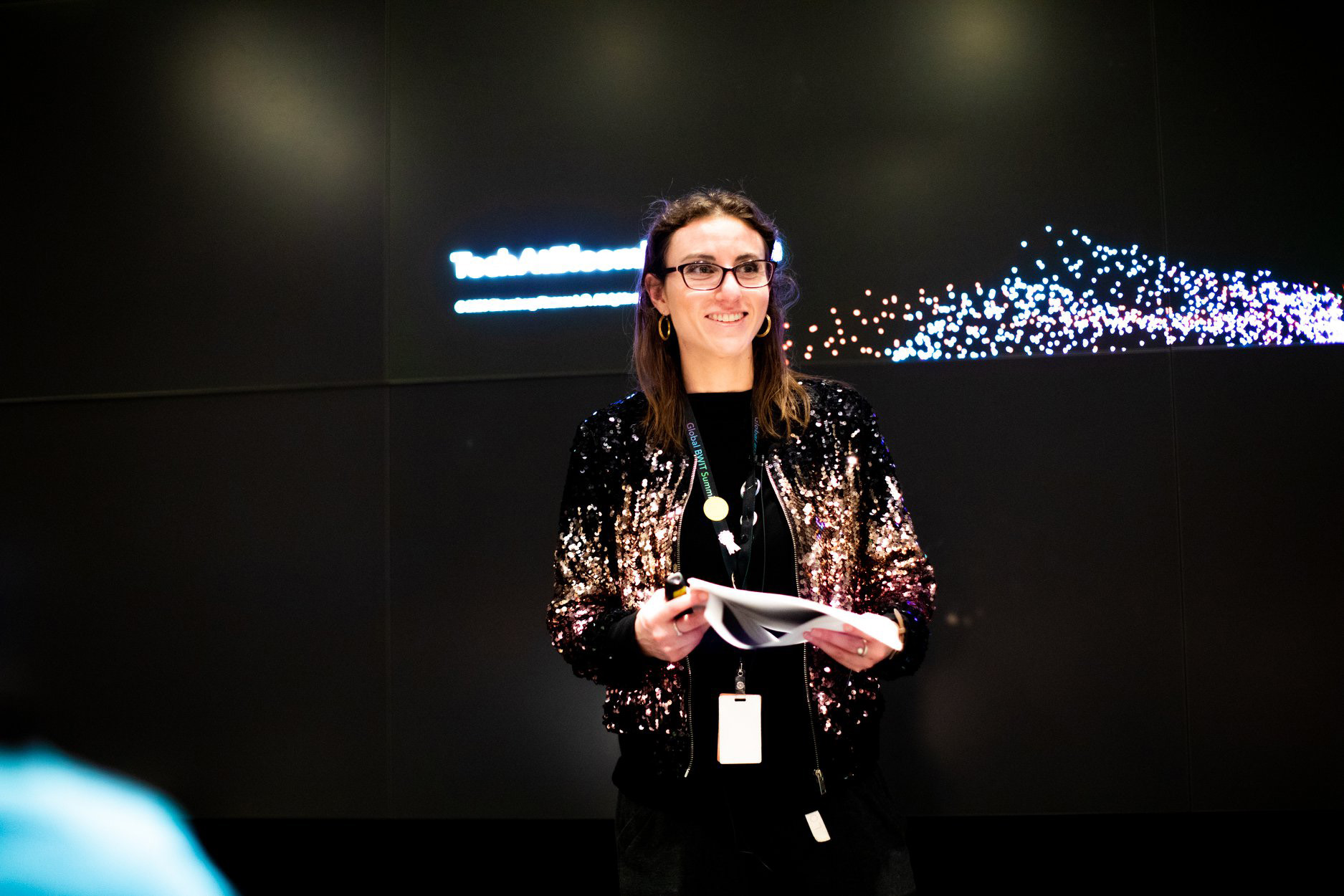
Bloomberg Engineering Software Engineer Alexandra (“Dobs”) Dobkin gives a talk on how to find your dream job at Bloomberg Engineering Girl Geek Dinner. Erica Kawamoto Hsu / Girl Geek X
Alexandra Dobkin: Yeah. Yeah. I love this crowd. You guys are great. I’m going to take you guys with me everywhere. I’ll be like yeah, follow the sequins. Yeah. All right. So as you can see, it says Alexandra Dobkin. That is my real name. As many of you might know, I go by Dobs, I will respond to Alexandra, I promise. But feel free to call me Dobs. So today I’ll be talking about finding your dream company.
Alexandra Dobkin: So what I want to do is go over the 10 questions to ask every future employer so you can figure out is this going to be the right company for me? So let’s go through a little history lesson. So for those of you that haven’t met me, I’m…?
Audience: Dobs.
Alexandra Dobkin: There we go. Yeah. I’m a software engineer working on Python API and the BQuant team. And if you’d like to know more about what that means, come talk to me after I’ll be the one in the sequins. So in case you can’t tell or can’t guess, I’ve been having an awesome experience here at Bloomberg. So quick show of hands or shout outs if you’re really excited, who’s been having an awesome time at their jobs?
Audience: Yay.
Alexandra Dobkin: Okay, so a lot of people. So seems like you guys have kind of figured out the secret sauce as have I, that… how to figure out what’s going on? I feel like a lot of people at Bloomberg just raised their hands. Yeah, okay. Yeah. So what’s it that’s giving me such an awesome experience? Part of it is the work that I’m paid to do that I find exciting.
Alexandra Dobkin: But that’s not everything. It’s how I’m treated, the attitudes that my coworkers have, the capacity for me to grow and progress in my career. I learned to appreciate my time here because, well, frankly, my previous work experiences were not the right fit for me. I used to work in management consulting, as well as finance, which had a vastly different culture to tech and especially a different culture from that at Bloomberg.
Alexandra Dobkin: So while programming is definitely cooler than these jobs, Bloomberg has definitely been a much better employer for me, as well. And an example of how Bloomberg has been better is this is what I wore to work today. I could get away with that in my previous careers. Obviously, that’s a problem. So I’ve been thinking about this, what’s been the difference between my previous employment that wasn’t the right fit, and my current employment, which is awesome? Aside from the sequins? So I’ve distilled my experience down to 10 facets that I realized I care about.
Alexandra Dobkin: I’ve talked to others about my findings, and they seem to agree. Let’s start talking about what are my 10 questions? So the first question I’d want to talk about is customer service. And the question is that you can ask is, how does the company treat its customers? So what is the customer? Who are Bloomberg customers? Can you take a guess?
Alexandra Dobkin: Yeah, okay, okay. So who’s a customer of our IT department? Yeah. Or of our HR department?
Audience member: Everyone.
Alexandra Dobkin: Yeah. So click, click. So how a company treats its customers is as important because it’s an indicator of how you will likely be treated at the company too. the ingrained attitude towards customer service translates into how you’re treated by much of the company. I know that Bloomberg prides itself in a first in class customer service experience. While that sounds great as an actual customer, paying customer, that’s really meaningful to me. I’m not a paying customer. I’m getting paid by Bloomberg sort of it.
Alexandra Dobkin: So often, and especially in larger companies, many team’s clients are actually internal. So the attitudes surrounding customer service will directly affect your interactions with your colleagues. So if a company does not treat its paying customers well, how can you expect them to treat their employees well?
Alexandra Dobkin: Yeah. So now let’s talk about philanthropy. So this begs the question, what is the company’s commitment to its community? How a company serves its community and the world at large is important because it is an indicator of its commitment to being kind. So moreover, people like to work for companies with similar values to their own. So if a person, say me cares about philanthropy will be more excited to apply to a company that promotes philanthropy. Pretty simple, right? Yeah.
Alexandra Dobkin: You guys are all smart here. So it’s pretty simple. But let’s take it one step further. There’s another reason why I care about working for a company that prioritizes philanthropy. It also draws other people to work that share those same altruistic values. And what I found is that people with altruistic values tend to be really nice, kind people. So in my professional opinion, it’s really nice to work with nice people. You can quote me on that.
Alexandra Dobkin: So a company that cares about philanthropy can lead to really kind coworkers. Love you guys. Okay, all right, health. What is the company’s commitment to health and wellness? An employee is an asset to a company and should be treated as such. How a company demonstrates its care for you beyond how it compensates you affects your quality of life. Because life happens.
Alexandra Dobkin: If you want a company that cares not only about your health care policy, but your overall health too. And it’s really important to know the difference between what perks are listed in your benefits package versus the culture around taking advantage of these perks. So raise your hand if you’ve ever heard a story of someone taking a three week vacation at a company that offered unlimited vacation, they come back and they’re canned. Oh, yeah, we got a few hands. Yeah, yeah, that kind of happens.
Alexandra Dobkin: While what is on paper can look attractive, it is not uncommon for there to be retaliation at companies for enjoying benefits, such as unlimited paid time off or taking a much needed unlimited sick days. Companies that talk the talk need to also walk the walk. It is crucial to know the benefits package is not only great but what you’re being offered on paper you’re actually truly entitled to in your experiences. So make sure you talk to employees, get anecdotes about people using benefits consequence free.
Alexandra Dobkin: I don’t have time for it, but oh boy, do I have an anecdote about how I have really, really appreciated having unlimited sick days and having a company that really cares about my wellness, calling to make sure that I’m feeling better and saying do not come back until you do. Diversity and inclusion. What would this talk be if I didn’t talk about diversity and inclusion, right? So hopefully this is an easy one that we can all agree on.
Alexandra Dobkin: Clap if diversity is important to you. Yeah. Okay. Love that sound. So good. So, I will blow throough this one quickly, because I’m pretty sure we’re all on the same page. How a company treats its under represented employees matters for all, not only for members of that community. There are definitely challenges that underrepresented groups face, microaggressions, biases, marginalization, exclusion, disrespect, inequality. I’m sure you guys can name a lot more. But a company that supports hiring diverse employees invariably supports diversity of thought. And this is a benefit for everyone, from minorities, non-minorities, to the company as a whole, is it allows for a more inclusive culture that welcomes different ideas.
Alexandra Dobkin: Diversity and inclusion makes… supports making workplaces a safe space to be yourself, whether you’re identify as minority group or not. Freedom from conformity allows you to bring your best self to work. In my case of sequins. All right, moving on. So let’s talk about culture. So when we think about culture, how many of you have heard the phrase, “work hard play hard”? Yeah. What’s your company like? Oh, yes. Some useless…
Alexandra Dobkin: So that’s the absolute worst way to define company culture. Because it really tells you nothing. Let’s put up a better quote. Okay, that’s better. So how do you define a company’s culture? Because culture is hard to talk about. It’s really big. Its leadership, it’s the seasoned employees. It’s the new hires, it’s the initiatives, it’s the goals, it’s attitude, it’s the customer service, it’s the attitudes towards philanthropy, the investment in health, the promotion of diversity. So everything that we just went over goes into it.
Alexandra Dobkin: Work should not be your life, but how you’re treated daily will affect your life. So take care to find a place that shares your values, will treat you how you want to be treated and have realistic expectations of how you should balance life and work. And I find this question, what are some examples that illustrate company culture really important? Because if you ask someone to give anecdotes, to give stories about, the brown bag lunches on Tuesdays, and how someone found their mentor, it’s a lot more telling than someone just listing the mission statement of the company or the values that the company subscribes to.
Alexandra Dobkin: All right, so this is something that we heard mentioned before, impact. So what’s impact? What’s an impactful role? And that means something different for everyone. So it’s important to figure out what does it mean to the company and what does it mean to you and where are those two relating. So, for example, when I was in finance, I was managing a billion-dollar portfolio that I was in charge of. I executed trades against it, made all investment decisions. Now does managing a billion-dollar portfolio sound impactful to you?
Audience member: Yeah.
Alexandra Dobkin: It wasn’t impactful at all to me. I was extremely bored. It wasn’t analytical. I was done with my job like the first 10 minutes… the first hour of the day and then I spent the rest of the day just, on BuzzFeed, I did not feel like I was making an impact at all. So, the impact that your job makes emanates from the challenges you face that becomes learning opportunities. Just because the company’s making waves in an industry, it does not necessarily mean that your job will be exciting.
Alexandra Dobkin: However, the converse is also true. You can be at a company making a splash and have a super thrilling job. So figure out how you define impact, what you want to achieve on a job. Does it mean working with large sums of money, like a billion dollars, affecting thousands of customers, maybe. Working with cutting edge technologies. Whatever you need on the job to feel like you are making an impact should be aligned with how the company representatives answer this question.
Alexandra Dobkin: All right. Let’s move along. Okay, feedback. So you definitely want to ask about feedback because the only way to know how you are performing and how you can improve is if it’s communicated to you via feedback. So most companies have a formal annual review process, pretty standard to find that. While that’s good, it’s not the most effective feedback sessions because frequency is a key part of an effective feedback loop. In order to have full transparency into your performance, it is the informal feedback you accrue throughout your day to day performance that will ultimately help you grow the most in the year.
Alexandra Dobkin: It’s important that how your work is perceived by your team and your management because that will become your performance review, affect your pay, I like to get paid, and ultimately your future opportunities. You and you alone are responsible for your professional development. Part of that responsibility means knowing how you are doing and having a plan for where you’re headed. You should have full insight into both. The way to get that is through quality and timely feedback.
Alexandra Dobkin: So just a recommendation, I like to have bi weekly check ins with my manager to make sure I know how I’m doing. All right, let’s talk about tools and technologies. So the tools offered to help you perform your job will directly impact your quality of life at work, especially if you’re in tech. Efficient tools and automated processes allow you to spend more time doing your work and less time doing manual processes, which I personally find very boring. Moreover, staying up to date with industry leading and current technologies gives you more transferable skills and will make you more competitive as an applicant for your next role.
Alexandra Dobkin: It is important that where you work positions you for success by maximizing your time spent doing the work and minimizes the time spent doing manual processes. Especially as a software engineer, where automating things is our passion and manual stuff is just the worst. I’m preaching to the choir here though, right? Yeah. So optimal work environments are a moving target. So companies need to prove to you that they’re aware of this and constantly striving for a best in class work experience.
Alexandra Dobkin: All right. Trainings. How a company trains its workforce demonstrates its investment in people. Quality trainings improves workplace learning and workforce effectiveness. It also builds your repertoire of skills, which make you more of an asset to the company and sets you up for success beyond the current role. A company’s investment in your professional growth and development makes you a more valuable employee. I value learning and growing my career, don’t you? Yeah. Then a great hallmark of your learning potential is measured by the number and quality of trainings a company offers.
Alexandra Dobkin: All right. Number 10, career potential. When evaluating a position it is important to assess the job as a building block to your career. A job should open doors for you and give you access to more opportunities at your own company, as well as externally. If a company is offering you a job but you but cannot see how your career will progress there, you’re looking at a dead end. To have a career at a company, you need to see other opportunities for professional development now, as well as in the future. So just to be clear, you don’t need to have a whole 10-year-plan mapped out. You don’t need to go like overboard with that.
Alexandra Dobkin: You just need to be able to have evidence that you’ll be progressing in your career. Even if you have no clue what your next step is. If you’re not going to retire anytime soon, then you want to make sure that the job will open doors for your career. So just to recap, 10 questions. One, oh the animation’s still working. There we go. That’s what’s up.
Alexandra Dobkin: So in everything that we covered, so one through six, we talked about customers, community, health and wellness, diversity and inclusion, culture, impact. Seven feedback, tools and technologies, trainings, and career path options. And then just as an aside, talking about the 11th question or the 12th, and 13th, and 14th, and how you’re going to carry on the rest of your conversations. When I was reflecting on my own experiences, and coming up with these own questions, a friend actually recommended a site to me. I don’t know if you guys have heard of keyvalues.com?
Alexandra Dobkin: Yes, no, maybe so, okay. Really cool site. And if you go /culturequeries, they actually have a lot of really great questions and kind of ask you questions to help you figure out the questions you should be asking. I personally feel it’s a really valuable experience to come up with your own questions based on analyzing what you value, but definitely check out the site for some inspiration. So with that, thank you. Yeah. All right. And one last note.
Alexandra Dobkin: So just as a final note, I just wanted to say, I’m so excited that Bloomberg is hosting a Girl Geek Dinner, not to take all the credit, but I totally came up with the idea and proposed it.
Audience Member: It’s true.
Alexandra Dobkin: It’s true, it’s true. But only because I personally attended a number of Girl Geek Dinners and I really thought the experience was so awesome and so amazing. For me, I’ll share that at the height I was going to have my early dinners… The height of my Girl Geek Dinners attendance was when I was job searching. I don’t know if you guys are job searching? For me, my whole tactic was I’ll go, I’ll network, obviously, eat the good food. I’ll network and I wanted to make sure I had a really solid conversation with at least one person, it didn’t have to be more than one, but a really good solid conversation.
Alexandra Dobkin: Got that business card and I got a first round interview, if not further, with every single Girl Geek dinner company that I attended. So I just want to say make the most out of tonight. Eat the food, it’s really awesome, and feel free to come talk to anyone, blue shirt, sparkles, whatever it is. So thank you.
Audience Member: Yay.
Narrator: What impact does extreme weather have on oil production in the North Sea? How is the one peso tax helping save an entire generation of children? If 70% of everything we buy is delivered by truck, what happens to your grocery bill when there’s a severe driver shortage? How can bread scarcity spark a global political revolution? Our planet is alive and interconnected, continually shifting, adapting, and growing. Every event bigger or small results in other events.
Narrator: At Bloomberg, you’ll investigate, examine, and interpret these unique and seemingly unrelated connection points in real time. The success of our business relies on people just like you… Who can look into the future and create groundbreaking technology… Research… And expert insight to answer the world’s most complex questions. When we solve problems with a greater sense of purpose… Change begins… Dots connect… Society excels…
Narrator: The world transforms when work has meaning. Your career thrives when you feel a deep connection to it. That’s why at Bloomberg, we work on purpose. Ready to find yours?
Mario Cadete: Great. Thank you everybody. Thanks speakers. I couldn’t have said it better myself. Not even close. Thanks to my team. Thanks to Girl Geek. Again, thanks to Bailey. Please come talk to us. I think we’re here till 8:30. Have some more food, drink and so on. It really has been a pleasure. Hopefully, you come and speak to me. I’d love to meet as many of you as possible. Thanks again.
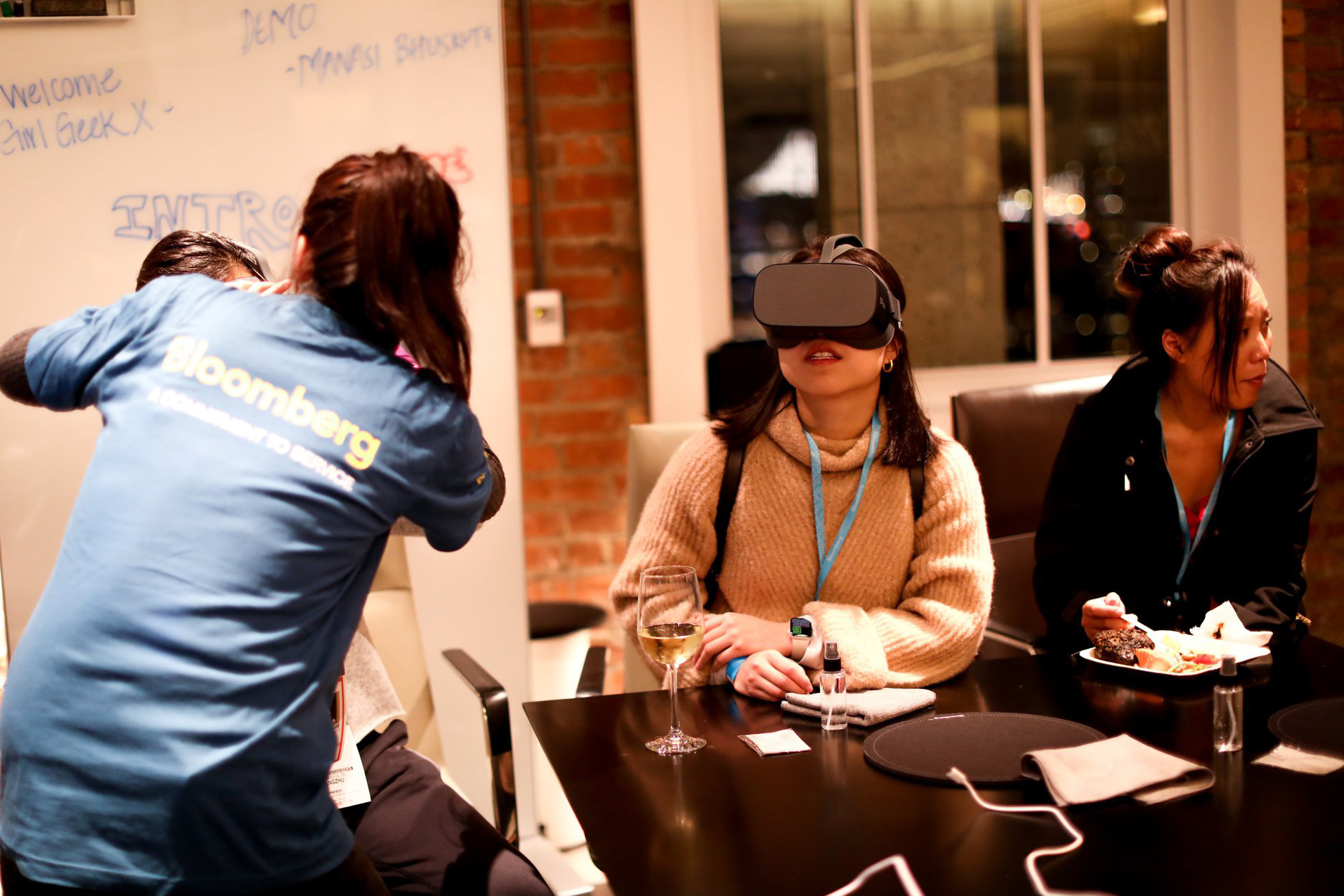
Thank you for coming out to Bloomberg Engineering Girl Geek Dinner with VR and Terminal demos, talks and networking! Erica Kawamoto Hsu / Girl Geek X
Like what you see here? Our mission-aligned Girl Geek X partners are hiring!



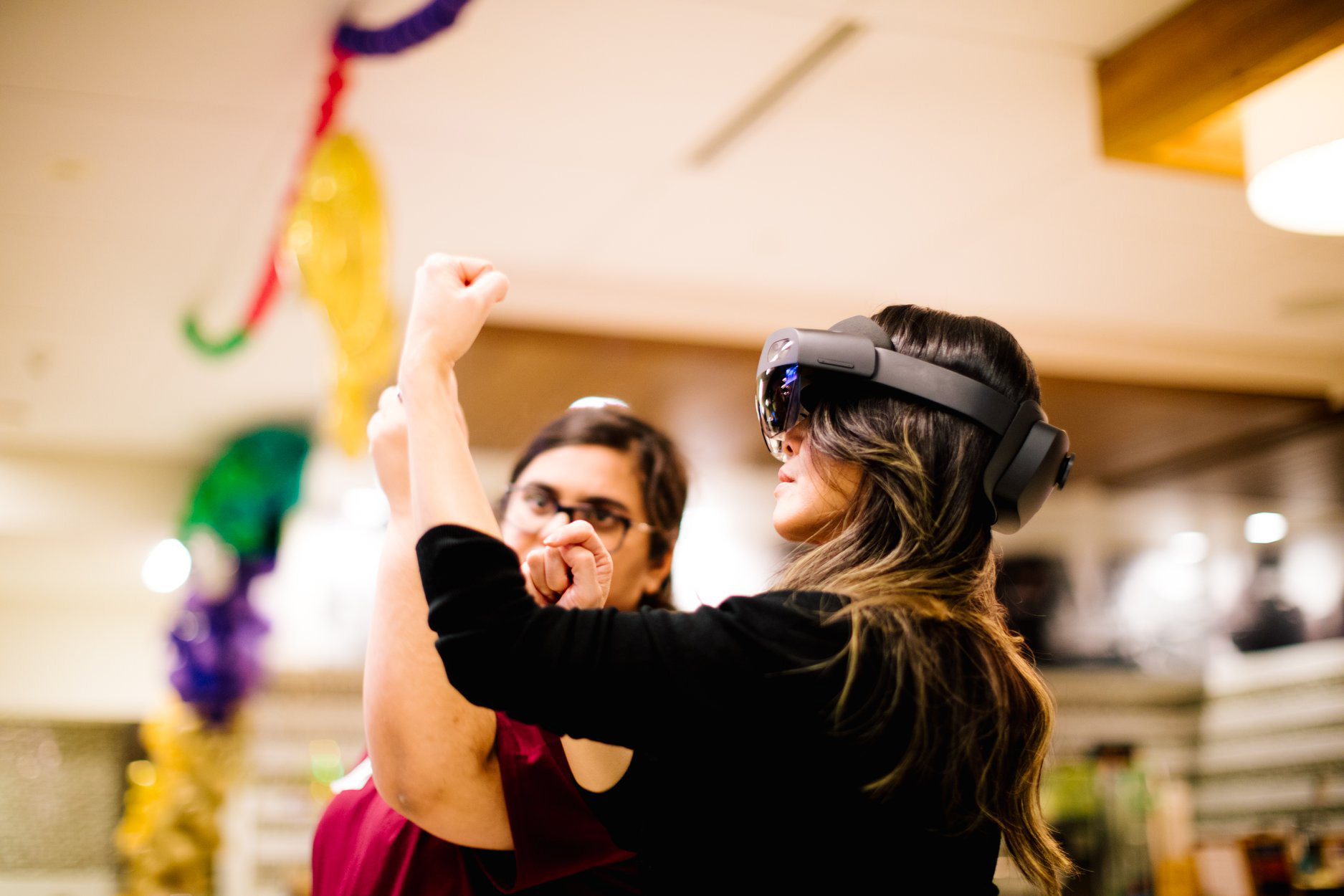 We enjoyed dinner and demos of HoloLens at the sold-out Microsoft Hardware Girl Geek Dinner in Sunnyvale, California. Erica Kawamoto Hsu / Girl Geek X
We enjoyed dinner and demos of HoloLens at the sold-out Microsoft Hardware Girl Geek Dinner in Sunnyvale, California. Erica Kawamoto Hsu / Girl Geek X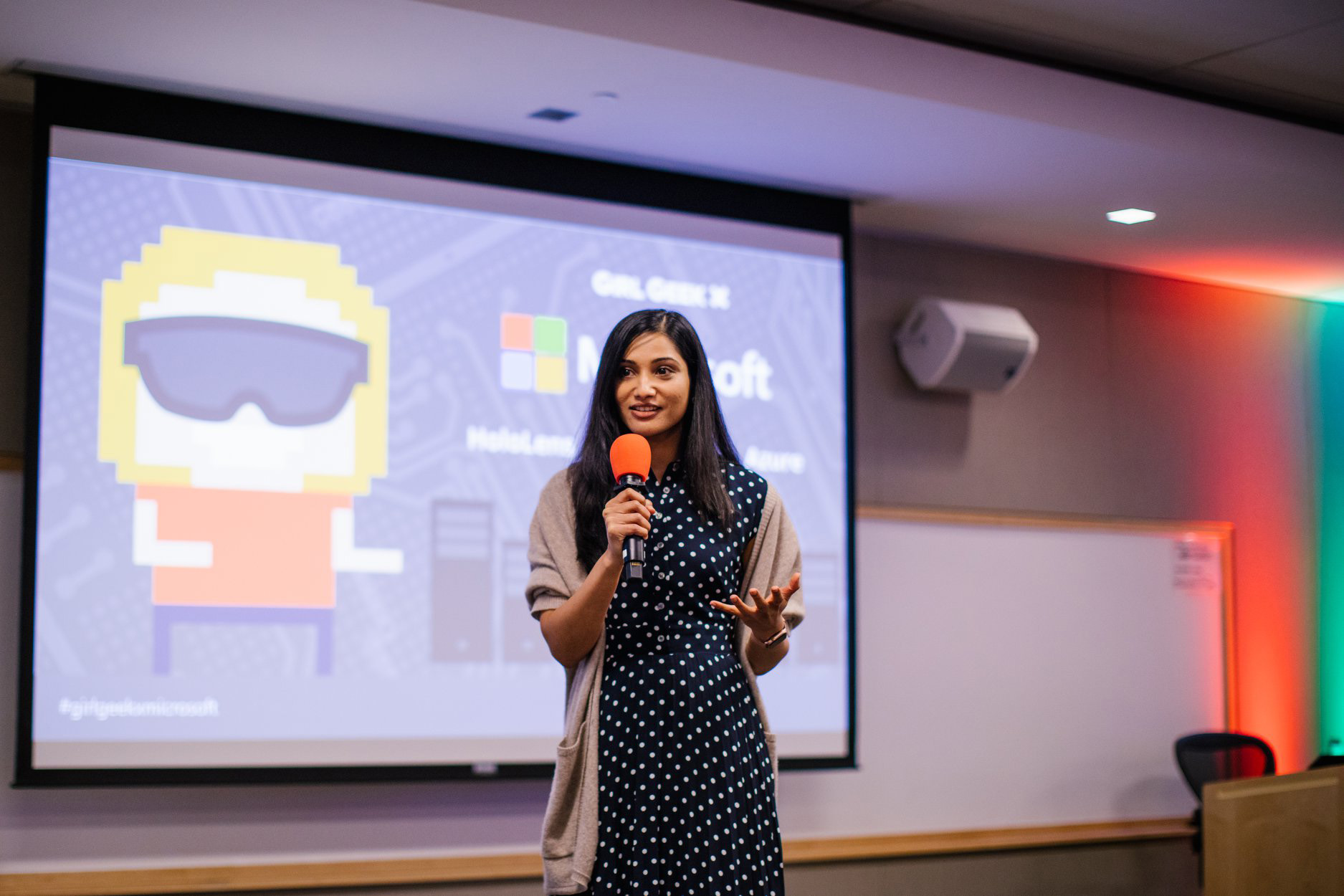 Microsoft Group Engineering Manager Aaratee Rao welcomes the audience and talks about her career at Microsoft Hardware Girl Geek Dinner. Erica Kawamoto Hsu / Girl Geek X
Microsoft Group Engineering Manager Aaratee Rao welcomes the audience and talks about her career at Microsoft Hardware Girl Geek Dinner. Erica Kawamoto Hsu / Girl Geek X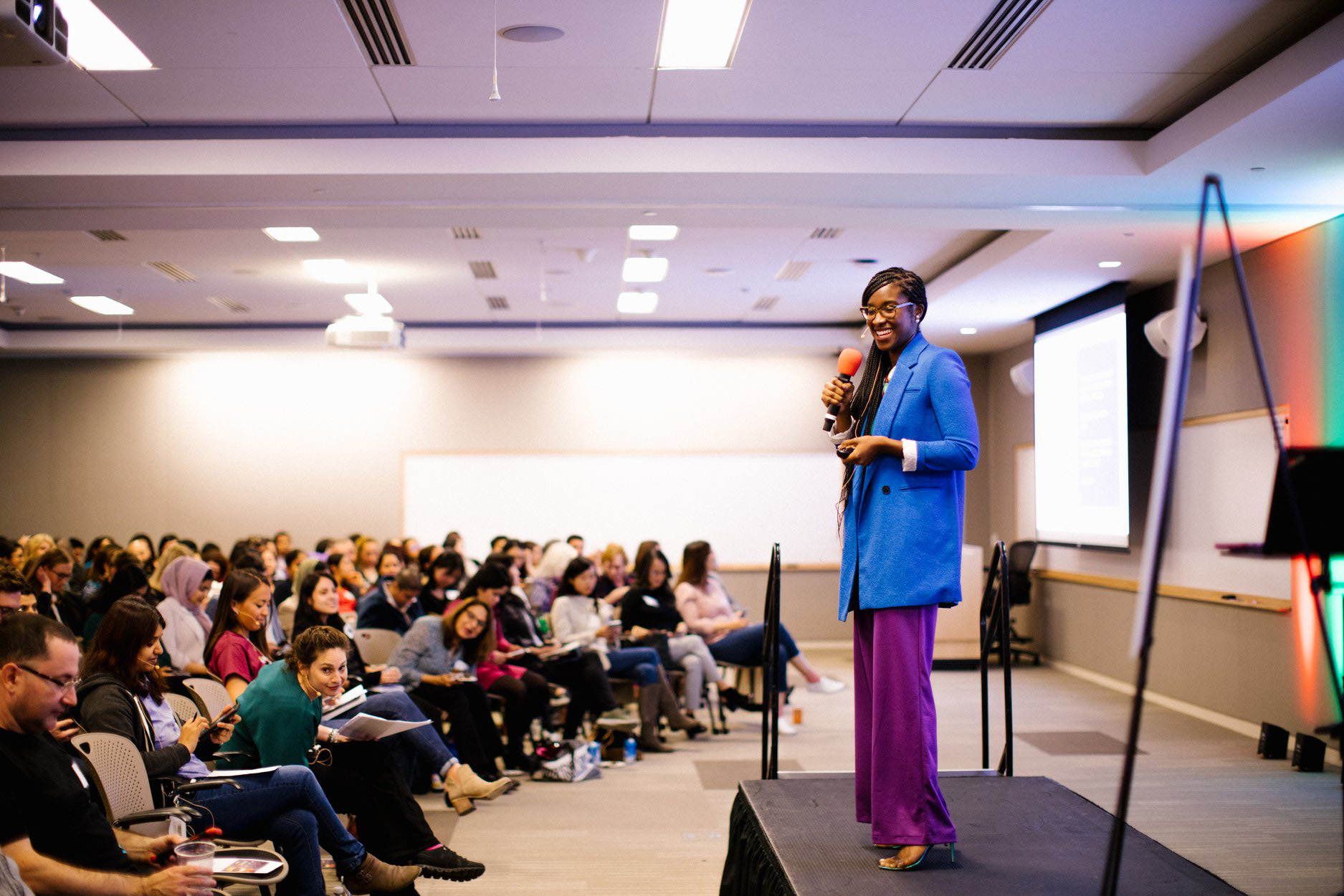 Microsoft Strategic Account Executive Safiya Miller gives a talk on what to do in the first 90 days of a new job at Microsoft Hardware Girl Geek Dinner. Erica Kawamoto Hsu / Girl Geek X
Microsoft Strategic Account Executive Safiya Miller gives a talk on what to do in the first 90 days of a new job at Microsoft Hardware Girl Geek Dinner. Erica Kawamoto Hsu / Girl Geek X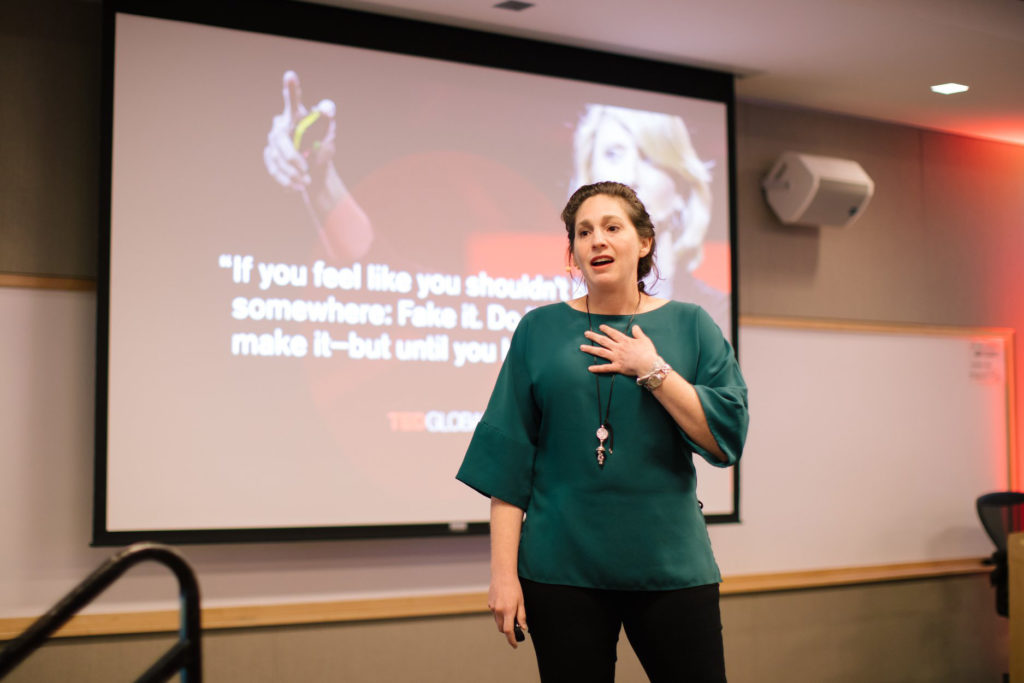
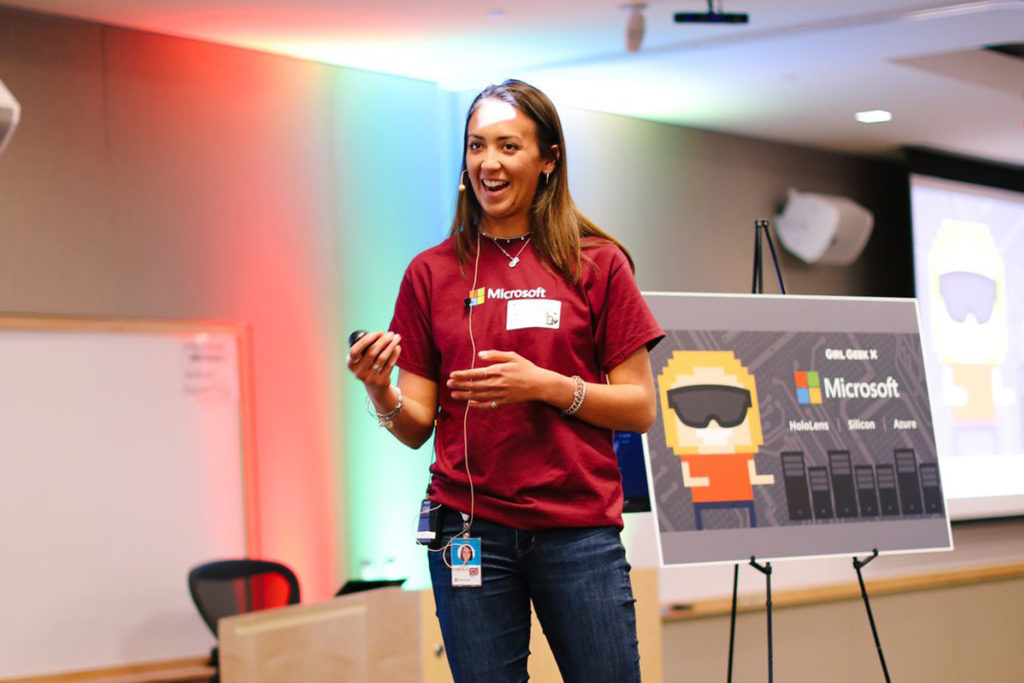 Microsoft Mechanical Engineer Carolyn Lee gives a talk on HoloLens at Microsoft Hardware Girl Geek Dinner. Erica Kawamoto Hsu / Girl Geek X
Microsoft Mechanical Engineer Carolyn Lee gives a talk on HoloLens at Microsoft Hardware Girl Geek Dinner. Erica Kawamoto Hsu / Girl Geek X